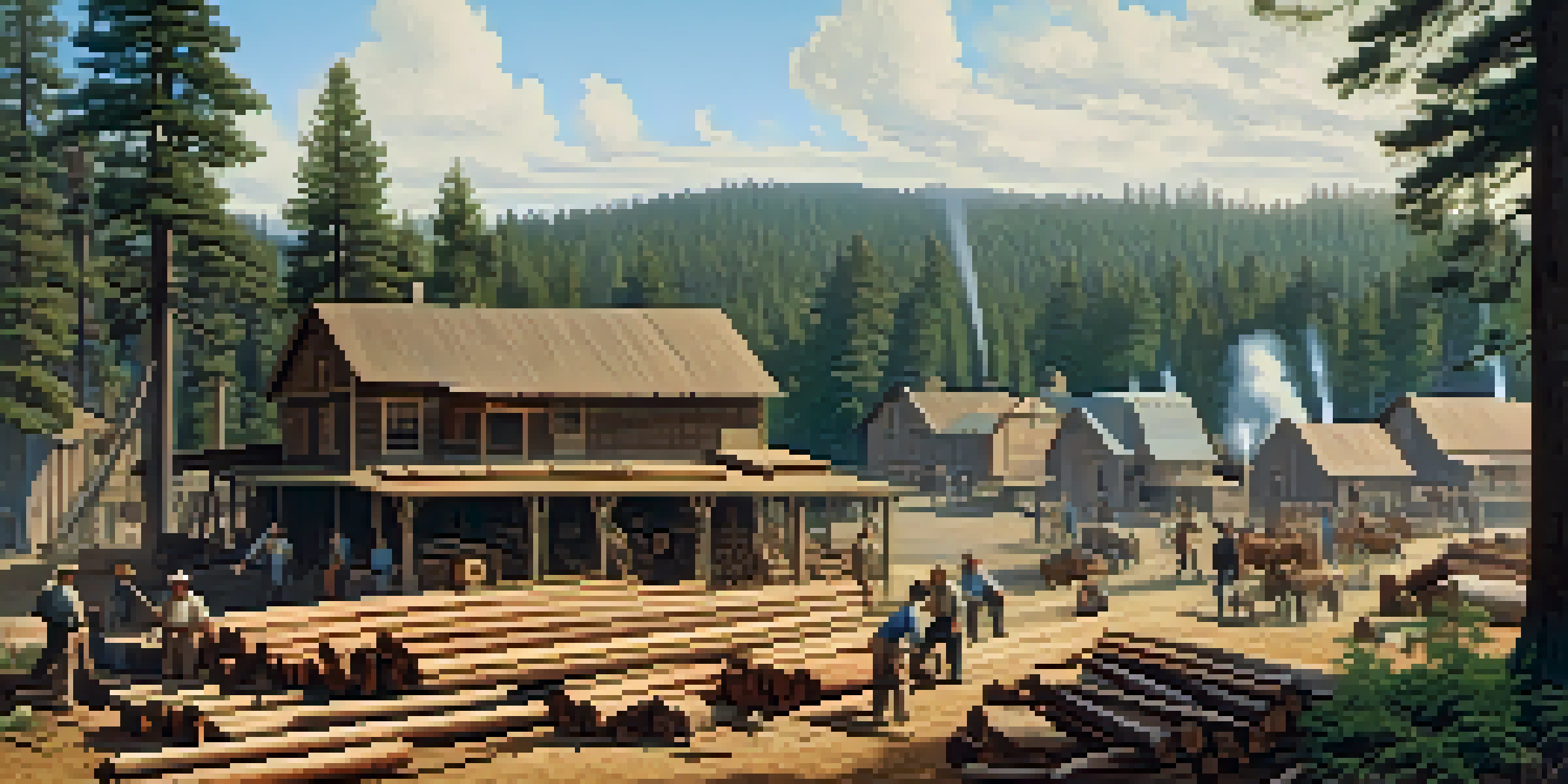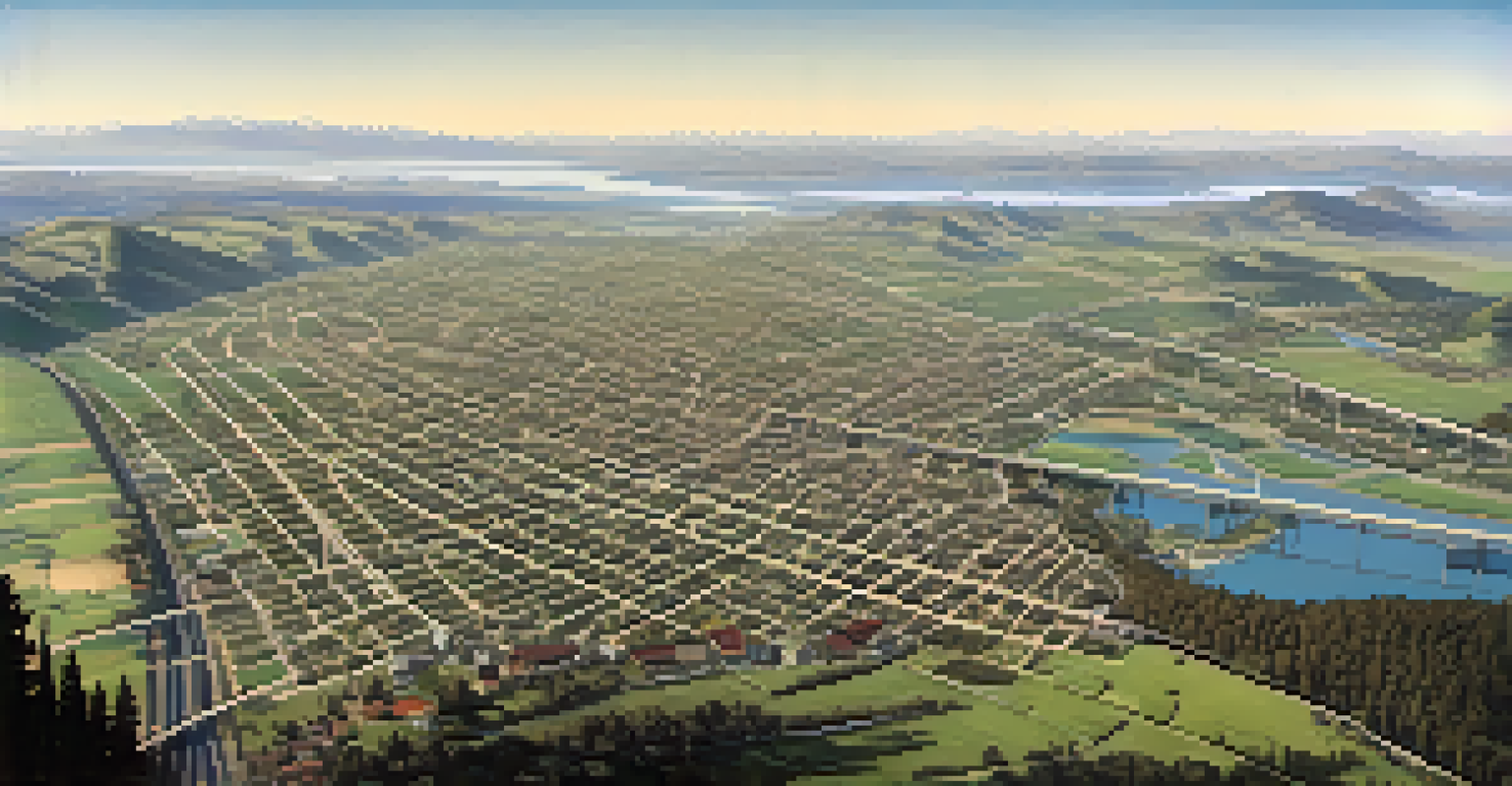Redwood City in the 19th Century: A Transformation

The Early Beginnings of Redwood City
Redwood City, founded during the California Gold Rush, saw its first settlers arrive in the 1850s. Initially, the area was known for its dense redwood forests, which attracted lumbermen and entrepreneurs. As word spread about the region’s potential, more people began to stake their claims and establish homes.
The past cannot be changed. The future is yet in your power.
During these early years, the town was primarily a lumber hub, serving the burgeoning needs of nearby communities. The natural resources available made it an attractive location for those looking to profit from the demands of a growing population. This foundational period set the stage for the transformation that would soon occur.
The establishment of the lumber industry not only brought wealth but also a diverse population. Immigrants from various backgrounds arrived, contributing to a rich cultural tapestry that would define Redwood City for decades to come.
The Rise of Transportation and Trade
As Redwood City began to grow, transportation became a key focus for its development. The arrival of the railroad in the 1860s was a game-changer, linking the town to larger markets and facilitating trade. This new mode of transport allowed for faster shipping of goods, particularly lumber, which was in high demand.

The railroad also brought an influx of visitors and potential residents, further fueling Redwood City's growth. Businesses began to pop up along the newly established routes, providing goods and services to both locals and travelers. This economic boom led to the development of a vibrant community.
Lumber Industry Shaped Early Redwood
Redwood City's initial growth was driven by the booming lumber industry during the California Gold Rush, attracting settlers and creating a diverse community.
By the end of the century, Redwood City became a vital transportation hub on the San Francisco Peninsula. Its strategic location made it an essential stop for goods traveling to and from the bustling city, solidifying its status as an important trade center.
The Impact of Agriculture on the Local Economy
While lumber and transportation were crucial, agriculture also played a significant role in Redwood City's transformation. The fertile lands surrounding the city were perfect for farming, and local farmers began to cultivate fruits and vegetables. This agricultural boom complemented the lumber industry, diversifying the local economy.
History is not a burden on the memory but an illumination of the soul.
Fruits like strawberries and vegetables such as artichokes became staples in the area, with local farmers finding success in supplying nearby markets. The combination of agriculture and lumber created a balanced economy that provided stability and growth. Many families settled in the area, drawn by the promise of a fruitful life.
By the late 19th century, agriculture had become just as important as lumber, allowing Redwood City to thrive even when lumber prices fluctuated. This dual economy laid the groundwork for a more resilient community, prepared for future challenges.
Cultural Developments and Community Life
As Redwood City grew, so did its cultural landscape. The influx of diverse populations brought various traditions, food, and festivals, enriching the community's social fabric. The establishment of schools, churches, and civic organizations fostered a sense of belonging among residents.
Local events and gatherings became common, providing opportunities for people to connect and celebrate their shared identity. The community spirit was vibrant, with parades, fairs, and cultural festivities creating lasting memories. This sense of community was essential for maintaining cohesion in a rapidly changing environment.
Transportation Fueled Economic Growth
The arrival of the railroad in the 1860s transformed Redwood City into a vital trade hub, linking it to larger markets and boosting local businesses.
By the end of the 19th century, Redwood City had not only transformed economically but also culturally. The blending of traditions and the creation of new social norms established a unique identity that would carry forward into the 20th century.
The Role of Technology in Transformation
The 19th century was a time of remarkable technological advancements, and Redwood City was not left behind. Innovations in machinery and transportation methods improved efficiency in both the lumber and agricultural industries. These technological shifts allowed local businesses to thrive and expand their reach.
The introduction of steam-powered sawmills revolutionized lumber production, enabling faster processing and higher output. Similarly, advancements in farming equipment made it easier for local farmers to manage their fields and increase crop yields. This technological progress was essential for meeting the demands of a growing population.
By embracing technology, Redwood City positioned itself as a leader in both lumber and agriculture. This forward-thinking approach not only spurred economic growth but also attracted further investment and interest in the area, setting the stage for future development.
Urban Development and Infrastructure Growth
As the population of Redwood City continued to rise, urban development became a necessity. Infrastructure improvements were made, including the construction of roads, bridges, and public buildings. These developments not only enhanced the aesthetic appeal of the city but also improved functionality and accessibility for residents and businesses.
The establishment of schools and hospitals reflected the community's commitment to public welfare and education. This focus on infrastructure laid the groundwork for a well-organized city, capable of supporting future growth and attracting newcomers. The transformation of Redwood City into a bustling urban center was well underway.
Agriculture Diversified the Economy
As agriculture flourished alongside lumber, local farmers cultivated essential crops, creating a balanced economy that supported the community's resilience.
By the end of the century, the once-small lumber town had evolved into a vibrant city with a diverse economy and a solid infrastructure. This urbanization marked a significant shift in the identity of Redwood City, paving the way for the challenges and opportunities that lay ahead in the 20th century.
The Legacy of 19th Century Transformation
The transformations that took place in Redwood City during the 19th century laid a strong foundation for its future. The combination of a robust economy, rich cultural diversity, and improved infrastructure created a city poised for growth. The lessons learned and the strategies employed during this transformative period would shape the community for generations to come.
As Redwood City entered the 20th century, it carried forward the spirit of innovation and resilience that characterized its earlier years. The legacy of this transformation can still be seen today in the city’s thriving economy and vibrant community life. The rich history of Redwood City serves as a testament to the power of adaptability and growth.

In reflecting on the 19th century, we can appreciate how the past continues to influence the present. The challenges overcome and the achievements realized during this period remain integral to the city's identity, reminding us of the journey that shaped Redwood City into the place it is today.